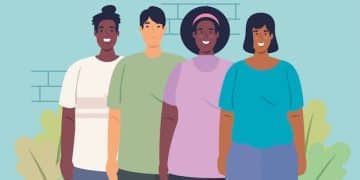Government Assistance: Programs for Seniors to Cover Expenses

Government assistance for seniors includes programs designed to help cover healthcare, housing, and living expenses, providing crucial support to older adults in need.
Navigating the landscape of government assistance can be challenging, especially for seniors. This guide breaks down the programs available to help cover healthcare, housing, and living expenses, ensuring a more secure and comfortable life.
Understanding Government Assistance for Seniors
Government assistance programs are vital resources for seniors, offering support to manage various aspects of life, from healthcare to housing. These programs aim to ensure that older adults can maintain a reasonable standard of living despite potential financial constraints. Knowing what’s available and how to access it is the first step toward securing this support.
These programs are designed to provide a safety net, helping seniors meet their basic needs and maintain their independence. Let’s delve into the details of these essential government assistance initiatives.

Types of Government Assistance Programs
Government assistance for seniors comes in various forms, each targeting specific needs. Some programs focus on healthcare, while others address housing or provide direct financial aid.
- Healthcare Programs: Such as Medicare and Medicaid, help cover medical expenses.
- Housing Assistance: Includes programs that offer subsidized housing or rental assistance.
- Financial Aid Programs: Provide direct cash assistance or help with utility bills and other essential expenses.
Understanding these different types of assistance can help seniors identify the programs that best fit their needs.
Healthcare Assistance Programs
Healthcare costs can be a significant burden for seniors. Fortunately, several government programs are available to help alleviate these costs and ensure access to necessary medical care. These programs provide financial assistance, insurance coverage, and other resources to support seniors’ health and well-being.
Let’s explore the primary healthcare assistance programs available to seniors in the US.
Medicare
Medicare is a federal health insurance program for individuals aged 65 and older, as well as certain younger people with disabilities or chronic conditions. It’s divided into several parts, each covering different aspects of healthcare. Medicare includes Part A (hospital insurance), Part B (medical insurance), Part C (Medicare Advantage), and Part D (prescription drug coverage).
- Part A: Covers inpatient hospital stays, skilled nursing facility care, hospice care, and some home healthcare.
- Part B: Covers doctor visits, outpatient care, preventive services, and some medical equipment.
- Part C: Allows beneficiaries to enroll in private health insurance plans that contract with Medicare to provide Part A and Part B benefits.
- Part D: Helps cover the cost of prescription drugs through private insurance plans.
Each part of Medicare has its own costs, including premiums, deductibles, and co-pays. Understanding these costs is crucial for budgeting healthcare expenses.
Medicaid
Medicaid is a joint federal and state program that provides healthcare coverage to low-income individuals and families. Unlike Medicare, which is primarily for seniors and those with disabilities, Medicaid eligibility is often based on income and assets.
Medicaid can help cover costs that Medicare doesn’t, such as long-term care, dental care, and vision care. Many seniors who have both Medicare and Medicaid (known as “dual eligibles”) can receive comprehensive healthcare coverage.
Housing Assistance Programs
Securing affordable and safe housing is a major concern for many seniors. Government assistance programs aim to provide solutions through subsidized housing, rental assistance, and home repair grants. These initiatives ensure that seniors have access to stable and adequate living environments.
Let’s take a closer look at key housing assistance programs that can make a significant difference in the lives of older adults.

Section 8 Housing Choice Voucher Program
The Section 8 Housing Choice Voucher Program, administered by the Department of Housing and Urban Development (HUD), provides rental assistance to low-income families, including seniors. This program allows seniors to choose their own housing, including apartments, townhouses, and single-family homes.
Eligible seniors receive a voucher that covers a portion of their rent, with the tenant paying the difference. The amount of the voucher is based on income and the local cost of housing. This flexibility makes the program a valuable resource for seniors seeking affordable housing options.
Public Housing
Public housing is another HUD program that provides affordable housing to low-income families and seniors. These housing units are owned and managed by local public housing agencies (PHAs).
- Rent in public housing is typically based on a percentage of the tenant’s income.
- Public housing offers a stable and secure living environment for seniors.
- Some public housing complexes are specifically designed for older adults, with features like accessible entrances and grab bars in bathrooms.
To apply for public housing, seniors need to contact their local PHA and complete an application. Waitlists can be long, so it’s important to apply as soon as possible.
Financial Assistance Programs
In addition to healthcare and housing, many seniors need financial assistance to cover their basic living expenses. Several government programs provide direct cash assistance or help with specific costs like utilities and food.
These programs can significantly improve the financial stability of seniors, allowing them to afford essential goods and services.
Supplemental Security Income (SSI)
Supplemental Security Income (SSI) is a federal program that provides monthly cash payments to aged, blind, and disabled individuals with limited income and resources. SSI is designed to help meet basic needs, such as food, clothing, and shelter.
To be eligible for SSI, seniors must meet certain income and asset requirements. The program can provide a crucial safety net for those with little or no income.
Supplemental Nutrition Assistance Program (SNAP)
The Supplemental Nutrition Assistance Program (SNAP), formerly known as food stamps, helps low-income individuals and families buy groceries. SNAP benefits are provided on an Electronic Benefit Transfer (EBT) card, which can be used at most grocery stores.
- SNAP eligibility is based on income and household size.
- Seniors can use SNAP benefits to purchase a variety of food items, including fruits, vegetables, meat, and dairy products.
- This program can help seniors maintain a healthy diet and avoid food insecurity.
Applying for SNAP is typically done through the state’s social services agency.
Applying for Government Assistance
Navigating the application process for government assistance programs can be daunting. However, understanding the general steps and resources available can make the process more manageable. Careful preparation and persistence are key to successfully applying for these benefits.
Let’s walk through the general steps involved in applying for government assistance.
Research and Eligibility
Before applying for any program, it’s essential to research the eligibility requirements and gather the necessary documents. Each program has specific criteria that applicants must meet to qualify for benefits. This step includes confirming age and residency, income level, medical status, and more.
Common documents include:
- Proof of age (birth certificate, driver’s license, or passport)
- Proof of income (Social Security statement, pay stubs, or tax returns)
- Proof of residency (utility bill, lease agreement)
It’s also helpful to look into whether the program requires an interview and what questions will be asked. Knowing this information ahead of time allows you to prepare and respond confidently.
Application Submission
Many government assistance programs offer online applications. Check the official government website or the program’s website for an online application portal. If the program doesn’t offer an online application, you can often download the application form and mail it in. Alternatively, you can visit a local office to pick up an application in person. Completing the application in full is essential, and you will need to submit the required documents. This is critical to avoid it being delayed or rejected. Mailing physical documents? Be sure to mail from a secure location and use certified mail.
Additional Resources and Support
Beyond the core government assistance programs, numerous additional resources and support services are available to help seniors navigate their financial challenges. These resources include non-profit organizations, community centers, and advocacy groups that provide assistance with applications, counseling, and other forms of support.
Accessing these resources can make a significant difference in the ease and success of securing government assistance.
Non-Profit Organizations
Numerous non-profit organizations are dedicated to assisting seniors in accessing government benefits. These organizations often provide application assistance, counseling, and referrals to other helpful resources. Examples include:
- AARP: Offers resources and advocacy for older adults, including information on government assistance programs.
- National Council on Aging (NCOA): Provides resources and support for seniors, including help with benefits enrollment.
- Area Agencies on Aging (AAAs): Local organizations that provide a range of services to seniors, including assistance with accessing government benefits.
These organizations can be invaluable resources for seniors and their families. Make sure to search for them in your local area.
Community Centers
Community centers often offer a range of services for seniors, including assistance with government benefits applications, health and wellness programs, and social activities. These centers provide a supportive environment where seniors can connect with others and access helpful resources.
Check your local area for available community centers. Many community centers offer senior-specific programs and benefits.
| Key Program | Brief Description |
|---|---|
| 🏥 Medicare | Federal health insurance for seniors covering hospital, medical, and prescription drug costs. |
| 🏠 Section 8 | Rental assistance for low-income seniors, allowing choice in housing options. |
| 💰 SSI | Monthly cash payments to aged, blind, and disabled with limited income. |
| 🍎 SNAP | Assistance for purchasing groceries, promoting a healthy diet for low-income seniors. |
Frequently Asked Questions
▼
The first step is to research available programs and determine your eligibility. Understand the requirements for each program you’re interested in.
▼
You can apply for Medicare through the Social Security Administration’s website or by visiting a local Social Security office. Enrollment periods vary.
▼
Common documents include proof of age, income, and residency. Specific requirements vary by program.
▼
Yes, it’s possible to receive assistance from multiple programs, such as Medicare and Medicaid, simultaneously, if you meet the eligibility criteria for each.
▼
Local Area Agencies on Aging (AAAs) and community centers often provide assistance. Non-profit organizations like AARP can also offer guidance.
Conclusion
Government assistance for seniors is a crucial resource for maintaining health, housing, and overall well-being. By understanding the available programs and taking the necessary steps to apply, seniors can significantly improve their quality of life and secure the support they need.





